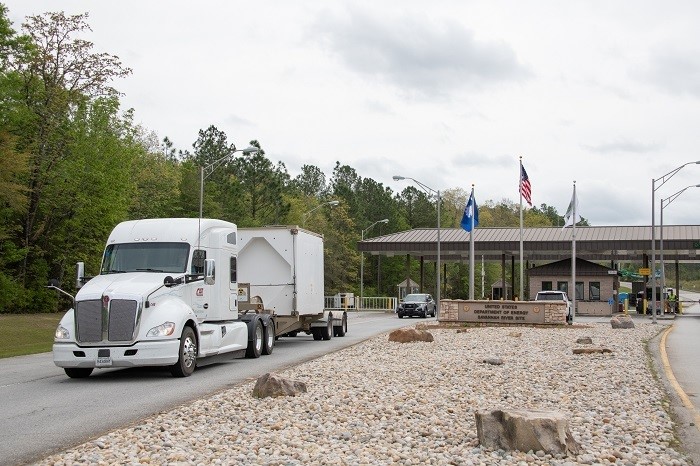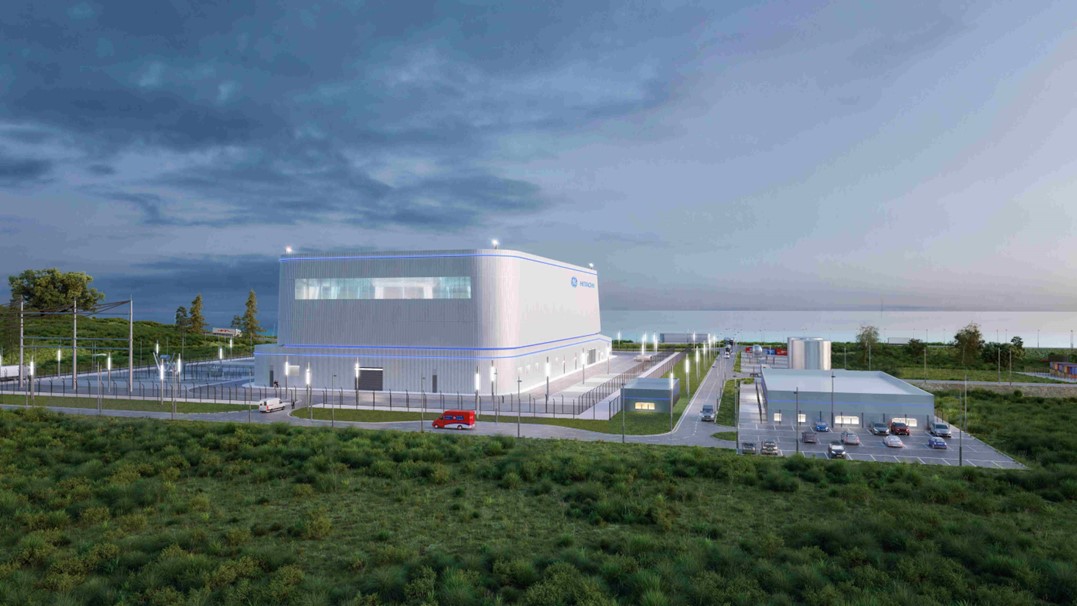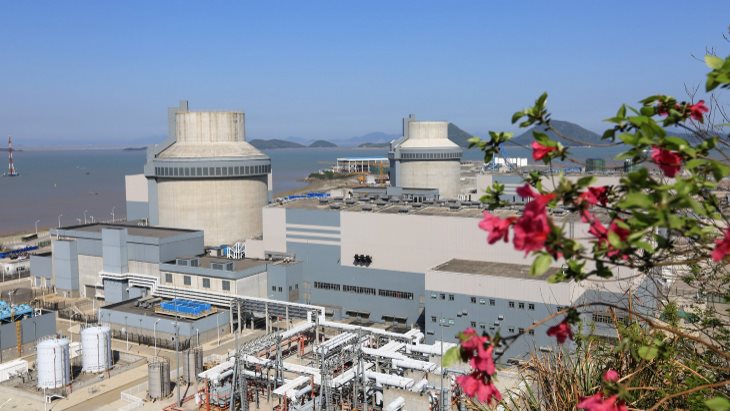During the Hanford Site's Direct-Feed Low-Activity Waste Program treatment operations, the Waste Treatment and Immobilization Plant, background, will feed liquid waste to the Liquid Effluent Retention Facility, foreground, through a primary transfer line pictured here. (Photo: DOE)
Work crews at the Department of Energy's Hanford Site recently completed the first transfer of test water from the Waste Treatment and Immobilization Plant's Effluent Management Facility to the nearby Liquid Effluent Retention Facility (LERF). The transfer of 6,000 gallons was the first simulation of the process that will be used to treat secondary liquid waste from the plant’s Low-Activity Waste Facility during operations to treat tank waste.
“This is a tremendous accomplishment that culminates years of work by our team and alumni toward being ready for hot commissioning,” said Valerie McCain, project director and senior vice president for Bechtel National, Inc. “It’s an important step for the entire Hanford team and our collective mission of protecting the Columbia River and its shoreline communities.”
Bechtel National is a contractor of the DOE's Office of Environmental Management's Office of River Protection.
The final legacy TRU waste shipment from Savannah River Site departs the site in mid-April, on its way to WIPP in southeastern New Mexico for permanent disposal. (Photo: DOE)
The Department of Energy reported this month that the final container of legacy transuranic waste from the Savannah River Site arrived at the Waste Isolation Pilot Plant for permanent disposal on the afternoon of April 14. The shipment capped the end of a journey for 239 shipments that began in 2011.
In all, trucks that carried the shipments weighed a combined 11,402,000 pounds and travelled more than 347,000 miles to the WIPP site.
Rafael Mariano Grossi speaks on a panel at the World Economic Forum Annual Meeting. (Photo: WEF)
Rafael Mariano Grossi, director general of the International Atomic Energy Agency, has authored an article for the World Economic Forum Annual Meeting held last week in Davos, Switzerland.
Government policies and innovative technologies are the key to fusion energy economics
May 27, 2022, 4:38PMNuclear NewsBart Gordon, Tim Peckinpaugh, Mike O’Neill, and Molly Barker Artist’s rendering of the U.K.'s STEP fusion reactor. (Image: U.K. Atomic Energy Authority)
Fusion energy is attracting significant interest from governments and private capital markets. The deployment of fusion energy on a timeline that will affect climate change and offer another tool for energy security will require support from stakeholders, regulators, and policymakers around the world. Without broad support, fusion may fail to reach its potential as a “game-changing” technology to make a meaningful difference in addressing the twin challenges of climate change and geopolitical energy security.
The process of developing the necessary policy and regulatory support is already underway around the world. Leaders in the United States, the United Kingdom, the European Union, China, and elsewhere are engaging with the key issues and will lead the way in setting the foundation for a global fusion industry.
Artist’s rendering of a BWRX-300 plant. (Image: GE Hitachi Nuclear Energy)
Ontario-based GEH SMR Technologies Canada Ltd. and the Saskatchewan Industrial and Mining Suppliers Association (SIMSA) announced yesterday the signing of a memorandum of understanding focused on the potential deployment of the BWRX-300 small modular reactor in Saskatchewan.
The MOU calls for engaging with local suppliers to maximize the role of the Saskatchewan supply chain in the nuclear energy industry.
Dae Chung, associate principal deputy assistant secretary for corporate services (second from left) and other EM officials recently toured the Paducah Site. Also pictured (from left) are Jennifer Woodard, acting senior advisor to Chung; Jolie Fleming, technical services director for Four Rivers Nuclear Partnership; and Lisa Phillips, physical scientist. In this photo, they discuss the new criticality accident alarm system in the C-333 process building at Paducah. The building is being deactivated to prepare for future demolition. (Photo: DOE)
Officials from the Department of Energy’s Office of Environmental Management recently got a firsthand look at cleanup progress being made at the Paducah Site in western Kentucky. The site is owned by the DOE, which is overseeing environmental cleanup activities there, including environmental remediation, waste management, depleted uranium conversion, and decontamination and decommissioning.
The visit by Dae Chung, associate principal deputy assistant secretary for corporate services, and other EM officials included stops at the C-400 cleaning building remediation project, the new Large Item Neutron Assay System (LINAS), and the C-333 process building deactivation.
Hinkley Point C’s Unit 2, in March of this year. (Photo: EDF Energy)
The target date for the start of electricity generation at Hinkley Point C’s Unit 1 reactor has been moved back to June 2027, following the completion of a schedule and cost review of the new nuclear build project, EDF announced last week.
While the review considered the main aspects of the project to construct two 1,630-MWe EPRs in Somerset, England, the schedule and cost of electromechanical works and of final testing were not examined, according to the utility.
University of Tokyo technical experts practice procedures for HEU packaging at the Yayoi Research Reactor, with help from Savannah River personnel. (Photo: University of Tokyo)
President Joe Biden and Prime Minister Fumio Kishida of Japan have announced the successful removal of more than 30 kilograms of high-enriched uranium from three Japanese sites to the United States. The news came in a May 23 statement from the Department of Energy’s National Nuclear Security Administration.
The world's first AP1000 reactors to enter operation, Sanmen units 1 and 2, in China. (Image: Westinghouse Inc.)
Westinghouse Electric Company and South Korea’s Hyundai Engineering & Construction have signed an agreement to “jointly participate in global AP1000 plant opportunities,” the Pennsylvania-based nuclear technology firm announced on May 24.
The first overseas NuScale Energy Exploration (E2) Center is planned for Romania. (Photo: NuScale)
Small modular reactor developer NuScale Power announced on Monday the signing of a memorandum of understanding with Romania’s Nuclearelectrica to conduct engineering studies, technical reviews, and licensing and permitting activities at a site in Doiceşti, Romania, selected as the preferred location for the deployment of a NuScale VOYGR power plant.















-2018.jpg)


